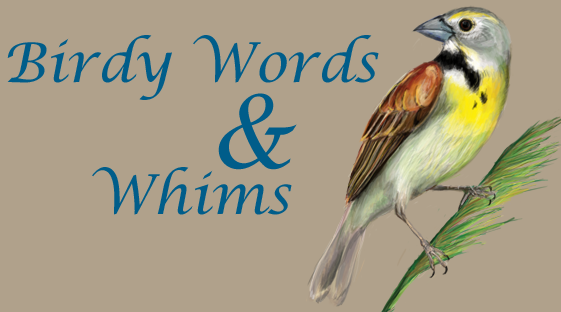The Grey Catbirds at Biocore Prairie were very active today. Several pairs must be nesting in the wooded areas alongside the prairie. One of which decided to build a nest right next to one of our net sites. The pair was very loud when I was setting up the net and definitely not happy. I'm guessing we'll become very familiar with that pair and their brood at the banding site.

Above is one of the three Grey Catbirds we banded this morning.

Here is a picture of one of our nets that we set up and take down each time we band. This is the one nearby the catbird nest.

All of the catbirds we got were adults. This can be confirmed by looking at the color of the inside of the mouth. Adult catbirds have all black mouths while the juveniles have a whiteish pink mouth interior.

Another view of a banded catbird, and a good look at that catbird characteristic red rump, or probably more appropriately known as "rusty undertail coverts."
 A lull in the morning was quickly interrupted when we had a Northern Flicker crash into one of the nets. I let Jerry deal with the giant Flicker while I got this tiny male American Goldfinch out.
A lull in the morning was quickly interrupted when we had a Northern Flicker crash into one of the nets. I let Jerry deal with the giant Flicker while I got this tiny male American Goldfinch out.
 I loved the mottling on this guy's head. You can tell he's relatively young since he still has some feathers more characteristic of the juvenile and female of the species.
I loved the mottling on this guy's head. You can tell he's relatively young since he still has some feathers more characteristic of the juvenile and female of the species.
 The Northern Flicker was just gorgeous. We hardly ever catch woodpeckers and this was my first time seeing one get banded. We have downy, hairy and red-bellied woodpeckers in the area as well but they usually stick to the more wooded areas. The Northern Flicker is probably the only woodpecker you will see around here that feeds on the ground and this species will actually make frequent use of the prairie area. The one that we caught was a male, which is evident by his black "mustache." And of course, only the males have mustaches.
The Northern Flicker was just gorgeous. We hardly ever catch woodpeckers and this was my first time seeing one get banded. We have downy, hairy and red-bellied woodpeckers in the area as well but they usually stick to the more wooded areas. The Northern Flicker is probably the only woodpecker you will see around here that feeds on the ground and this species will actually make frequent use of the prairie area. The one that we caught was a male, which is evident by his black "mustache." And of course, only the males have mustaches.
 I love all the details and decoration on this bird, it's almost like a piece of modern art. The plumage may be showy, but there are actually not many differences between the sexes in this bird. This Flicker is also known as a "Yellow-shafted Flicker" which is a sub-species. The Yellow-shafted and red-shafted used to be thought of as two separate species, but they often interbreed. If you see this bird in flight, look for red or yellow on the underwings. All of the Flickers I've seen at Biocore Prairie have yellow shafted wing feathers like this one, but I believe it's still possible to see the red-shafted variation somewhere around here.
I love all the details and decoration on this bird, it's almost like a piece of modern art. The plumage may be showy, but there are actually not many differences between the sexes in this bird. This Flicker is also known as a "Yellow-shafted Flicker" which is a sub-species. The Yellow-shafted and red-shafted used to be thought of as two separate species, but they often interbreed. If you see this bird in flight, look for red or yellow on the underwings. All of the Flickers I've seen at Biocore Prairie have yellow shafted wing feathers like this one, but I believe it's still possible to see the red-shafted variation somewhere around here.
Here is a quick video of the Flicker being released into the wild.. yaay. (Look for the yellow on the wings!)
Banded Bird Count for the Day: Grey Catbirds (3), American Goldfinch, Common Yellowthroat, Northern Flicker
Other birds observed: Willow Flycatcher, Ruby-throated Hummingbird, Indigo Bunting, Yellow Warbler, Baltimore Oriole, Song Sparrow, Black-capped Chickadee, Red-winged Blackbird, Tree Swallow

Barn Swallow
 Here is a picture of one of our nets that we set up and take down each time we band. This is the one nearby the catbird nest.
Here is a picture of one of our nets that we set up and take down each time we band. This is the one nearby the catbird nest.  All of the catbirds we got were adults. This can be confirmed by looking at the color of the inside of the mouth. Adult catbirds have all black mouths while the juveniles have a whiteish pink mouth interior.
All of the catbirds we got were adults. This can be confirmed by looking at the color of the inside of the mouth. Adult catbirds have all black mouths while the juveniles have a whiteish pink mouth interior. Another view of a banded catbird, and a good look at that catbird characteristic red rump, or probably more appropriately known as "rusty undertail coverts."
Another view of a banded catbird, and a good look at that catbird characteristic red rump, or probably more appropriately known as "rusty undertail coverts."








No comments:
Post a Comment